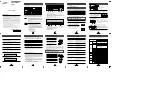
Accelnet & Stepnet Plus Panels User Guide
16-01339 Rev 07
CAN
C
OMMUNICATION
D
ETAILS
(BPL/BP2/TP2)
CAN
N
ETWORK AND
CAN
OPEN
P
ROFILES FOR
M
OTION
The BPL/BP2/TP2 communicate over a two-wire Controller Area Network (CAN).
The CAN specification defines the data link layer of a fast, reliable network and is an international standard
ISO 11898-1. The physical layer is a two-wire, serial-data connection.
CANopen is the CAN-based higher-layer protocol for embedded control systems. CiA 402 is the CANopen
profile for drives and motion controllers, internationally standardized in IEC 61800-7-201 and
IEC 61800-7-301. It is supported by Copley CANopen servo and stepper drives, allowing them to operate in
the following modes of operation: Profile Position, Profile Velocity, Profile Torque, Interpolated Position, and
Homing.
S
UPPORTED
CAN
OPEN
M
ODES
•
Profile Position
: Mode 1
The drive is programmed with a velocity, a relative or absolute target position, acceleration and
deceleration rates. On command, a complete motion profile is executed, traveling the programmed
distance or ending at the programmed position. The drive supports both trapezoidal and s-curve profiles.
•
Profile Velocity
: Mode 3
The drive is programmed with a velocity, a direction, and acceleration and deceleration rates. When the
drive is enabled, the motor accelerates to the set velocity and continues at that speed. When the drive
is halted, the velocity decelerates to zero.
•
Profile Torque
: Mode 4
The drive is programmed with a torque command. When the drive is enabled, or the torque command
is changed, the motor torque ramps to the new value at a programmable rate. When the drive is halted,
the torque ramps down at the same rate.
•
Homing
: Mode 6
Used to move the axis from an unknown position to a known reference or zero point with respect to the
mechanical system. The homing mode is configurable to work with a variety of combinations of encoder
index, home switch, and limit switches.
•
Interpolated Position
(PVT, or Position, Velocity, Time): Mode 7
The controller sends the drive a sequence of points, each of which is a segment of a larger, more
complex move, rather than a single index or profile. The drive then uses cubic polynomial interpolation
to “connect the dots” so that the motor reaches each point at the specified velocity at the programmed
time.
















































